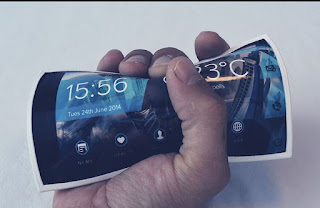FLEXIBLE SCREEN of smart phone n tv
FLEXIBLE SCREEN
WE ALL HEARD ABOUT THE SCREEN WHICH BENDS AND STILL WORK FLAWLESSLY , TODAY'S DISCUSSED TOPIC IS
FLEXIBLE SCREEN
latest technology news Recently we seen the Samsung galaxy s6 and s6 edge which is launched with flexible curved screen Samsung is developing its technology and more than that, promise than will release a new flexible display. according to Samsung " Galaxy S6 has been shipped in over ten million units to distributors and retailers, in both variants, S6 and S6 EDGE "
It does not mean that only sumsung is developing the flexible screen concept there are more top company's which are working on this concept.
LG is the competitive partner of sumsung ,LG released OLED PANEL which has a HIGH DEFINITION class resolution of 1200x810 with almost one MILLION MEGAPIXELS .
Introduced by
Xerox PARC
The concept of developing a flexible display was first put forth by Xerox PARC (Palo Alto Research Company). In 1974, Nicholas K. Sheridon, a PARC employee, made a major breakthrough in flexible display technology and produced the first flexible e-paper display. Dubbed Gyricon, this new display technology was designed to mimic the properties of paper, but married with the capacity to display dynamic digital images. Sheridon envisioned the advent of paperless offices and sought commercial applications for Gyricon. In 2003 Gyricon LLC was formed as a direct subsidiary of Xerox to commercialize the electronic paper technology developed at Xerox PARC. Gyricon LLC's operations were short lived and in December 2005 Xerox closed the subsidiary company in a move to focus on licensing the technology instead.
then later , In 2005, Arizona State University opened a 250,000 square foot facility dedicated to flexible display research named the ASU Flexible Display Center (FDC)
NOW HOW ACTUALLY IT WORKS
THIS FLEXIBLE SCREEN IS MADE BY THE OLEDs . oleds are the type of leds in which the emissive electromagnetism layer is a film of organic compound that emits light in response to an electric current. This layer of organic semiconductor is situated between two electrodes; typically, at least one of these electrodes is transparent .
These OLEDs are used in making the flexible screen , smart phones ,television etc
Mostly we know about the type of OLED (2 DIFFERENT TYPE OF WORKING MODE)
- PASSIVE MATRIX OLED ( PMOLED SCREEN )
- ACTIVE MATRIX OLED ( AMOLED SCREEN )
An OLED display works without a backlight; thus, it can display deep black levels and can be thinner and lighter than a liquid crystal display(LCD). In low ambient light conditions (such as a dark room), an OLED screen can achieve a higher contrast ratio than an LCD, regardless of whether the LCD uses cold cathode fluorescent lamps or an LED backlight.
KEY FEATURES
- IT'S LIGHT WEIGHT AND HAS CLEAR DISPLAY.
- Its able to work in wide temperature difference range .
- It can bear some vibrations.
- bearable in shock condition.
this area is steel developing , most fast acceptance is from the sumsung , which going to launch the flexible screens in GALAXY S7 series .
FOLLOW ME AND SHARE THIS.





Really Good Blog, Thanks for sharing Valuable information,more information Visit Below Links.
ReplyDeleteflipkart-affiliate-program
affiliate marketing flipkart
flipkart affiliate marketing